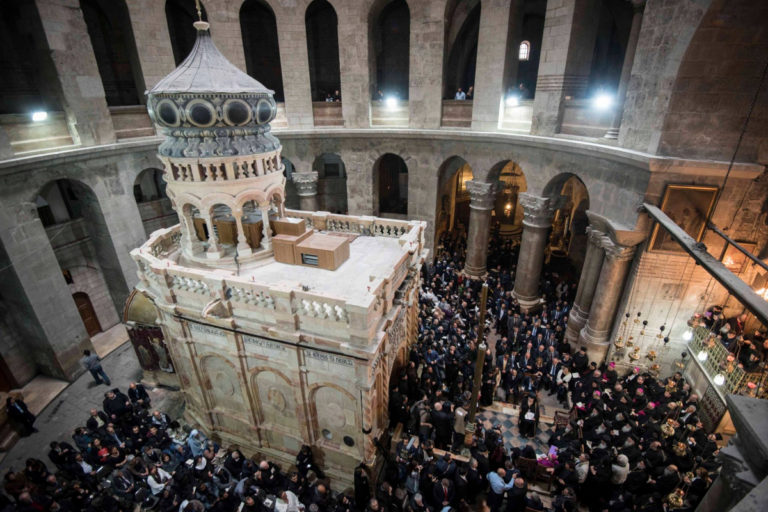
The Aedicule of the Holy Sepulchre was solemnly inaugurated on 22 March 2017 after a year of restoration by an ecumenical ceremony attended by representatives of the Orthodox, Armenian and Roman Catholic Churches. It was presided by the Ecumenical Patriarch Bartholomew, in the presence of Patriarch Theophilos III of Jerusalem, the Armenian Apostolic Patriarch Nourhan Manougian and other Christian religious leaders, as well as diplomats and political leaders like Greek Prime Minister Alexis Tsipras and the representatives of the Kingdom of Jordan, the State of Israel and the Palestinian Authority.
Under the current status quo, only the Orthodox, Armenian and Roman-Catholic Churches can celebrate services in the Holy Sepulchre basilica. The restoration work on the Tomb of Christ began less than a year ago in May 2016 to preserve the Tomb in the event of a powerful earthquake, like the one that struck the country in 1927 that weakened the Aedicule. The last work of consolidation of the Anastasis dates back to those devised by the British in 1947, who had been unable to complete the restoration because there was no agreement between the three Christian communities: Orthodox, Armenians and Franciscans who share custody of the Basilica. For the first time since the status quo of 1857, an agreement was finally reached between the three Christian communities, which was essential to commence the restoration work last year. This delicate project, which presented both technical and ecumenical challenges, was finally completed successfully.
The inauguration ceremony was a sign of unity, bringing together all of the communities, authorities and representatives of the Churches of the Holy Land, as well as many religious, faithful and benefactors. In his address, the Ecumenical Patriarch Bartholomew thanked the “honourable scholars of the National Polytechnic of Metsovo headed by the distinguished Prof. Antonia Moropoulou” for their work. He underlined that “in our contemporary, ever troubled and divided world, the Holy Sepulchre before which we stand constitutes the sole source of genuine, substantial and sacred unity among Christians that is not established upon human interests and ambitions, but only upon the Cross that is able to unite what was previously divided”.
For Patriarch Theophilos III of Jerusalem, “the aedicule restoration has an ecumenical significance for the whole human family because this sacred place brings closer all nations, ethnic groups and cultures and is an eloquent testimony of a destiny and shared humanity.” The work is a show of unity that can be an inspiration “for all the peoples of our region, especially at this time of difficulty and confusion for our world.” Theophilos also thanked Jordan’s King Abdullah II and Palestinian Authority President Mahmoud Abbas for their donations.
Armenian Apostolic Patriarch Nourhan Manougian mentioned the Passion and commandment of love of Jesus who “told us that to be his disciples we must love one another”. “My dear brothers,” he went on to say, “we all read the same Gospel, the same words, translated into our language. We have no difference of opinion on this commandment. Christian solidarity is a sign that our love for Christ goes beyond our cultural, liturgical and linguistic differences.” The Armenian Patriarch also mentioned the possibility of allowing, once a year after Easter, other churches to officiate in the aedicule. “I am certain that our Lord Jesus Christ would love it.”
In his address, the Custos of the Holy Land, Fr Francis Patton, expressed hope for peace and joy for the completion of the work in time for Easter, which this year falls on the same day for Catholics and Orthodox. This represents a kind of restoration for “all Christianity” that helps the Churches become closer, and able to work together and feel “as brothers”.
“This restoration marks not only the achievement of an important technical objective, but also a new stage in our relations,” noted the former Custos Fr Pierbattista Pizzaballa, who today is the apostolic administrator. “The aedicule becomes a concrete symbol of a new restored site, the life of the Churches of Jerusalem.” For him, the Holy Sepulchre, in which all Christians remember the resurrection of Jesus, is the mirror of what we are. “We want to heal the wounds of a divided history. This restoration sprinkled oil and balm on the wounds of the body of Christ which is the Church.”